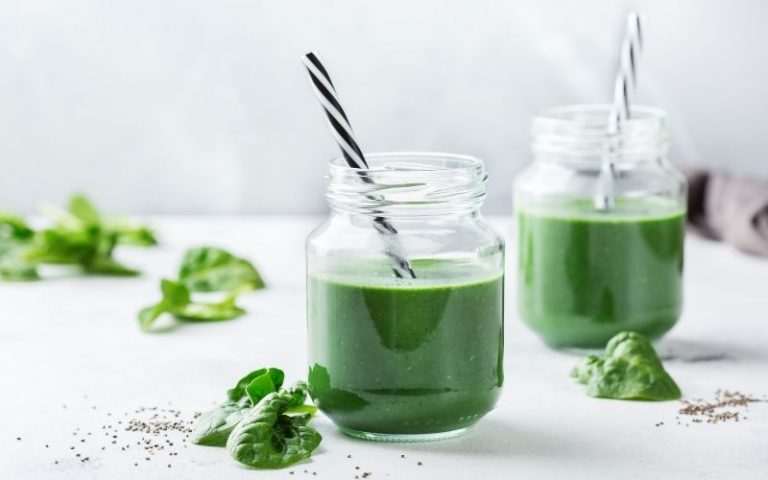The Surprising Truth Between Dairy And Acne, Nutritionist Explains

A cold ice cream cone on a summer’s day. A whey protein shake after a hard workout. A baguette with cheese.
Could these dairy foods be contributing to your acne?
Some studies show that dairy consumption may be a culprit in contributing to acne breakouts.
Many adolescents and adults suffer from acne vulgaris (that’s the technical term for acne). In fact, it is estimated that 50-95% of adolescents have acne (1).
Teenage boys have the highest rate of acne but girls and women are more likely to seek out a dermatologist.
What causes acne?
There are many factors. Genetics, hormones, environmental factors, stress, and even the foods you eat can contribute to acne breakouts (1).
Acne sufferers should know what foods are potentially linked to acne. These include:
- High glycemic load diets
- Fast food like burgers
- Fatty and fried foods like french fries and potato chips
- Milk and dark chocolate
- Dairy foods
There are also several biological causes of acne development (1):
- Excess sebum production
- Excess acne-promoting bacteria
- Blocked hair follicles
- Hormonal changes leading to inflammation
The above 4 factors contribute to the pathogenesis, or developent, of breakouts.
Many studies show that milk intake might contribute to some of these factors and cause skin issues. Let’s investigate.
What counts as dairy?
Let’s clarify what dairy is.
Simply put, a dairy product is any food that comes from cow’s milk.
This includes: cow’s milk, cheese, cream cheese, cottage cheese, butter, yogurt, cream, ice cream, and whey protein.
Remember that many packaged foods have dairy products in their ingredient lists, too.
Eggs are not a dairy food – this is a common misconception!
What the studies say
Recent studies show that dairy may play a role in causing zits, but the research is not 100% conclusive yet.
Let’s walk through a couple of studies to see what the science says about dairy and breakouts.
Study #1
In 2020, Penso et al. published an observational study with 24,000 people.
The investigators asked the participants what types of foods they ate and how severe their acne was. The participants then had to write down all the foods and drinks they consumed for 3 full days.
The researchers found that the more dairy products people consumed, the more likely they were to have zits.
Sugary, fatty, and greasy foods were also associated with increased acne prevalence. Since this was an observational study, it does not prove that dairy causes acne.
But it does show an assocation betwen dairy intake and acne (2).
Study #2
In 2018, Aghasi et al. did a “meta-analysis” on dairy and acne vulgaris. A meta-analysis is when the data from multiple studies are combined together.
Combining all the data together allows us to learn more than if we were just looking at 1 study.
Aghasi et al. searched through respected databases and compiled 14 studies on dairy and acne. The age range of participants in the studies ranged from 9 years old to 30 years old.
So we are talking about pre-teens, teens in high school, and adults.
The investigators found that the people who had the highest milk consumption were more than twice as likely to have acne compared to the people who consumed the least amount of dairy.
In the meta-analysis, it did not matter if it was skim milk, low-fat milk, or whole milk – they were all associated with acne (3).
Study #3
Another study by Aalemi et al found an association between dairy and acne, with whole milk being more likely to cause acne than skim milk (4).
As you can see, study results are not consistent on if it’s skim, lowfat, or whole milk that is most likely to cause acne.
Interestingly, some studies have found that yogurt and cheese were not found to have an association with acne. (4) In other words, a glass of milk may be more of the issue.
Yogurt, which is fermented milk, contains healthy probiotics. Probiotics are benefical bacteria.
We are still waiting for clinical trials to confirm whether or not dairy causes acne.
A clinical trial is when researchers divide people into 2 groups (one group is a control group) and they are very carefully monitored for the development of acne.
This would allow us to determine a definite link between dairy and acne
For now, the observational studies are convincing that there is a correlation between dairy and acne.
So how exactly might dairy cause acne?
First let’s talk about where dairy comes from. Dairy milk comes from female cows that just had a baby calf. The baby cow drinks its mother’s milk so it can grow and thrive.
How does milk help a calf grow? Milk has proteins and hormones to help calves grow (and it helps us grow, too!)
Dairy is a common food in most Western societies.
Insulin levels
Some of the proteins in dairy include whey protein and casein. When we drink milk, these milk proteins cause a spike in some hormones in the human body. One hormone that increases in the bloodstream is insulin.
High insulin levels cause more sebum and oil production to occur and are linked to pimple breakouts. Remember, excess sebum contributes to clogged pores.
High insulin can also lead to insulin resistance.
IGF-1
Another hormone found in dairy is called insulin-like growth factor-1 (IGF-1). IGF-1 is also found naturally in our bodies. But when we drink milk, it increases our IGF-1 levels even higher.
Like insulin, higher IGF-1 levels also contribute to excess production of sebum.
Sometimes, pregnant cows are also given growth hormones to increase their milk supply.
This growth factor in the milk can cause the hormones in our own bodies to get out of whack, potentially affecting our androgen hormones: dihydrotestosterone (dht), testosterone and estrogen.
In the meta analysis by Aghasi et al., yogurt and cheese were not found to be associated with acne development.
This may be because they are made by fermenting milk.
The fermentation process may change the dairy and lower its IGF-1 hormone levels, possibly making it less prone to causing a breakout.
Lactose
You also may have heard of lactose.
Lactose is a type of sugar found in dairy (milk sugar). I
n lactose-intolerance, the body lacks the enzyme to digest lactose. If you are lactose-intolerant and you consume dairy, it can worsen the severity of acne due to digestive system troubles.
But dairy can worsen acne severity even in people who are not lactose-intolerant.
Can you grow out of it?
Teens during puberty who get acne may have hormonal acne due to hormonal fluctuations.
It can range from severe acne with cysts/scarring to just a few pimples on your cheek, jawline, or forehead messing with your complexion.
Acne is most common in adolescents and young adults, but adult acne is common too.
Fifty percent of women in their twenties deal with acne, thirty percent of women in their 30s and a quarter of women in their 40s have acne (1).
But don’t despair!
Skincare regimes, like a cleanser, moisturizer or other certain products can help clear your skin.
Products include Accutane (a severe acne treatment using isotretinoin related to vitamin a), or antibiotics, birth control pills, or other dermatologist-recommended treatments (prescriptions or over the counter products) can help with breakouts.
In addition, changes in what you eat might help with your unsightly blemishes.
So as you can see, acne patients are people of all ages.
Some acne medications might have side effects.
Consider making a diet change like removing dairy and see if that helps your skin!
How to test this out
Working with a dermatologist can help you figure out your skin condition.
However, there are some methods you can try at home to see if dairy is causing your acne.
Elimination diet
One method is a dairy elimination diet.
An elimination diet is when you remove a certain food from your diet for a specific amount of time, and see if your symptoms improve.
Then you re-introduce the food and see if the symtpoms return.
For a dairy elimination diet:
1. Stop eating any dairy products for 3-4 weeks. This means avoiding cow’s milk, cheese, yogurt, butter, cream, whey, and ice cream. Read ingredient labels to ensure there is no dairy hidden in there.
2. During that time, monitor your skin. Are your breakouts less severe?
3. After 3-4 weeks, try eating some dairy food several days in a row. Does your skin breakout? If so, that’s a sign that your new pimples are caused by dairy.
If your skin woes improve when you don’t eat dairy, perhaps you continue a dairy-free diet.
Or you may try to introduce 1 dairy food at a time to see if there is a specific one that aggravates your skin.
If you saw no change when you ditched dairy, then it may be that dairy is not causing your acne. Everyone is different.
Elimination diet tips
Here are some tips for your elimination diet.
- Make sure to carefully read ingredient labels to make sure a milk product isn’t hiding in there (it’s hiding in a lot of foods!) Ingredients such as “whey,” “casein, and “cream” are all dairy products.
- Be patient. Clear skin won’t happen overnight. It may take several weeks (it may feel like a long time!) for your body to see significant improvement and clear skin.
- You may choose to eliminate 1 dairy food at a time. For example, maybe you decide to just eliminate milk but you keep yogurt and cheese in your dietary pattern. That way you can isolate if one dairy food is linked to your skin issues.
You may also want to work with a dietitian or healthcare professional to guide you through the elimination diet.
Dairy alternatives
If you do decide to ditch dairy and go for a dairy-free diet because dairy gives you an acne flare, it’s important to keep a few nutrients in mind.
Dairy is an important source of calcium, protein, phosphorus, and vitamin D.
To keep your body functioning well, including immune system function, you’re going to want to make sure you get these nutrients from other foods.
The good news is there are many options at the grocery store. If you have a craving – don’t worry! Many milk and cheese alternatives are available. Don’t give up after your first week!
Milk alternatives include beverages like soy milk, almond milk, oat milk, and flax milk. Soymilk has the most similar nutrients compared to cow milk.
Coconut milk is high in saturated fat, so it may be best to limit coconut milk.
If you’re trying to limit your dairy intake but not trying to limit your ice cream consumption, opt for ice cream made from plant-based milks which can be just as tasty — without all the factors that cause hormonal acne.
Keep in mind that almond milk and oat milk do not have very much protein — they are still perfectly fine, but make sure you get your protein from other foods (like meat, fish, eggs, tofu, legumes like beans, or nuts like almonds, walnuts, and peanuts).
A few tips for choosing a dairy-free milk:
- Choose an unsweetened one to cut down on sugar
- Choose one that has added calcium, vitamin A, and vitamin D (check the ingredients to see if these are is added)
Non-dairy foods that are high in calcium include tofu, kale, oranges, almonds, and chia seeds. Consume calcium-rich foods daily.
If you’re someone who drinks protein shakes, alternatives to whey protein powder include soy protein powder or pea protein powder.
Try to meet your nutrition needs with food before you turn to a supplement. If you do take a supplement, consult your doctor or dietitian and make sure it is third party tested.
The glycemic effect
High glycemic load foods also cause an increase in blood sugar followed by an insulin spike that may promote inflammation.
If you have sensitive skin, this may lead to skin problems like whiteheads, blackheads, redness, pimples, cystic acne,eczema, rashes rosacea, and acne in general.
The glycemic index measures how much foods raise blood sugar.
High glycemic foods include (but are not limited to): white bread, white rice, white pasta and soda. What’s similar about these foods? They are high in simple carbohydrates.
On the contrary, foods that are lower on the glycemic index include oatmeal, green leafy vegetables like kale and spinach, and protein foods.
These foods (and others) are part of a healthy diet that supports healthy skin.
If you eat an unhealthy diet, acne breakouts can develop. This is because some foods promote excess oil or sebum. Sebum is an oily substance produced by sebaceous glands on the skin.
Excess sebum, oil, and dead skin cells build up clog pores, causing pimples.
Cystic acne can come into play when the pimple gets infected and red, with swelling causing irritation and painful bumps.
Overall
So, we hope you have learned a lot about acne and dairy!
The takeaway message is that many observational studies show a possible link or correlation between dairy and acne.
The way milk consumption might worsen acne severity is by the proteins and hormones in dairy causing some hormonal changes in our own bodies.
The increased serum hormones cause increased sebum production from the sebaceous glands (oil glands), which causes oily skin, clogged pores, and acne.
We are still waiting for clinical research to confirm this.
Other foods that may be causing breakouts include a high-glycemic foods and high glycemic load diet(simple carbs), chocolate, and greasy foods.
So cut out those sweets and junk food, and add in more whole foods to your healthy diet especially vegetables, fruits, whole grains, nuts, legumes, and healthy omega-3 fatty acids – with sweets only in moderation.
Everyone’s skin is different. How your own body reacts to milk products may be different than someone else’s.
Whether you have teenage acne or adult acne, you could try a dairy elimination diet to see if the blemishes on your skin clear up.
If you end up completely ditching dairy, make sure to include calcium foods elsewhere in your diet.
Try working with a dietitian nutritionist to help you meet your nutrition needs if you go dairy-free or not.
Regardless of if you ditch diary completely, don’t have as much dairy as you did before, or keep dairy in your diet, a lifestyle change to a healthy diet can help improve your skin!
1. Baldwin, Hilary, and Jerry Tan. “Effects of Diet on Acne and Its Response to Treatment.” American journal of clinical dermatology vol. 22,1 (2021): 55-65. doi:10.1007/s40257-020-00542-y
2. Penso, Laetitia et al. “Association Between Adult Acne and Dietary Behaviors: Findings From the NutriNet-Santé Prospective Cohort Study.” JAMA dermatology vol. 156,8 (2020): 854-862. doi:10.1001/jamadermatol.2020.1602
3. Aghasi, Mohadeseh et al. “Dairy intake and acne development: A meta-analysis of observational studies.” Clinical nutrition (Edinburgh, Scotland) vol. 38,3 (2019): 1067-1075. doi:10.1016/j.clnu.2018.04.015
4. Aalemi, Ahmad Khalid et al. “Dairy consumption and acne: a case control study in Kabul, Afghanistan.” Clinical, cosmetic and investigational dermatology vol. 12 481-487. 1 Jul. 2019, doi:10.2147/CCID.S195191





